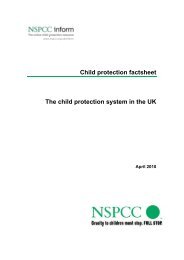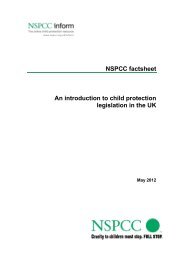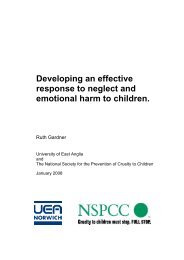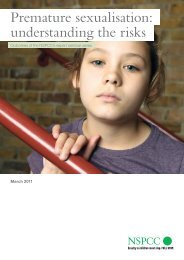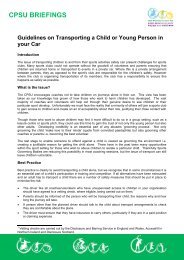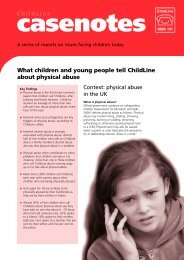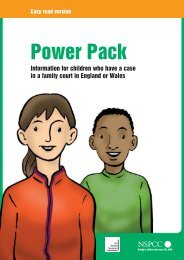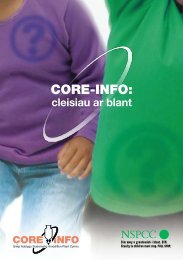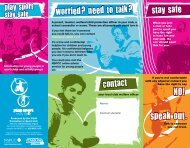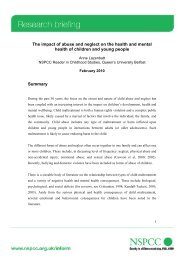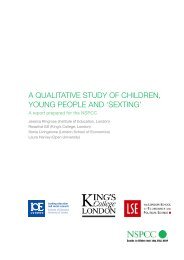Neglect and serious case reviews (PDF, 735KB) - nspcc
Neglect and serious case reviews (PDF, 735KB) - nspcc
Neglect and serious case reviews (PDF, 735KB) - nspcc
You also want an ePaper? Increase the reach of your titles
YUMPU automatically turns print PDFs into web optimized ePapers that Google loves.
<strong>Neglect</strong> <strong>and</strong> Serious Case Reviews<br />
professional responses<br />
All seven young people had experienced multiple types of maltreatment, multiple losses,<br />
separation <strong>and</strong> feelings of ab<strong>and</strong>onment. For most there was evidence of unresolved<br />
issues about this ab<strong>and</strong>onment – with one young person always seeking out his mother<br />
<strong>and</strong> wanting to be reunited but experiencing repeated bouts of rejection. Most had<br />
limited sources of support <strong>and</strong> were isolated. There was little evidence in the <strong>reviews</strong><br />
that practitioners working with these young people knew their early history <strong>and</strong> took it<br />
into account to underst<strong>and</strong> their development <strong>and</strong> their behaviour as an adolescent.<br />
Many of the older young people, like Frazer, had long histories of involvement with<br />
a number of agencies (especially children’s social care [CSC], child <strong>and</strong> adolescent<br />
mental health services [CAMHS] <strong>and</strong> youth offending teams [YOTs]). Serious professional<br />
concerns about neglect <strong>and</strong> its impact on the child’s emotional health were<br />
often apparent from when the child was very young or were picked up when the child<br />
first started school. An example of this is when a teacher spoke of, ‘an angry, frightened<br />
little boy who would wait at school for his mother, but she would often not come, be late<br />
or be under the influence of alcohol or drugs.’<br />
Athough some young people had been the subject of neglect child protection plans<br />
over long periods <strong>and</strong> were in <strong>and</strong> out of care, it was also possible for some to do well<br />
(intermittently) at school <strong>and</strong> perhaps to have an excellent attendance record. School<br />
could be a place of safety that young people might try to return to even when they were<br />
excluded from school. There could be good engagement between the young people <strong>and</strong><br />
both school staff <strong>and</strong> CAMHS workers, ‘the CAMHS worker was in frequent <strong>and</strong> regular<br />
touch for the subsequent three years, developing a strong therapeutic relationship<br />
despite X’s reputation for being difficult to engage.’<br />
Carers were not adequately supported to cope with one young person’s behaviour<br />
especially when he became ‘threatening <strong>and</strong> dangerous’ leading to another rejection.<br />
Children’s social care closed the <strong>case</strong> at this point of heightened need, when the young<br />
person was aged 14 ‘allowing’ him to live with family friends. Serious offending led to<br />
custody but at the point of discharge from custody, children’s social care still maintained<br />
the decision that he was ‘No longer a priority’ for a service <strong>and</strong> would not have received<br />
support had he lived long enough to be discharged. The consequences of a ‘wait <strong>and</strong> see’<br />
approach (Gardner 2008) are as damaging <strong>and</strong> dangerous to young people of this age as<br />
they are with much younger children.<br />
lack of support in the transition to adulthood<br />
74<br />
There was evidence of young people asking children’s social care to be accommodated,<br />
in one instance because at the age of 16 the young person could no longer tolerate his<br />
mother’s alcohol abuse <strong>and</strong> lack of food <strong>and</strong> care at home. Such requests for help from<br />
older young people tended to be refused by children’s services who thought these were<br />
lower level <strong>case</strong>s more appropriate to be referred for support to other agencies. At the<br />
age of sixteen many vulnerable young people lose the protection offered by school <strong>and</strong><br />
struggle to find any other protected routes to adulthood, <strong>and</strong> no routes out of a neglectful




